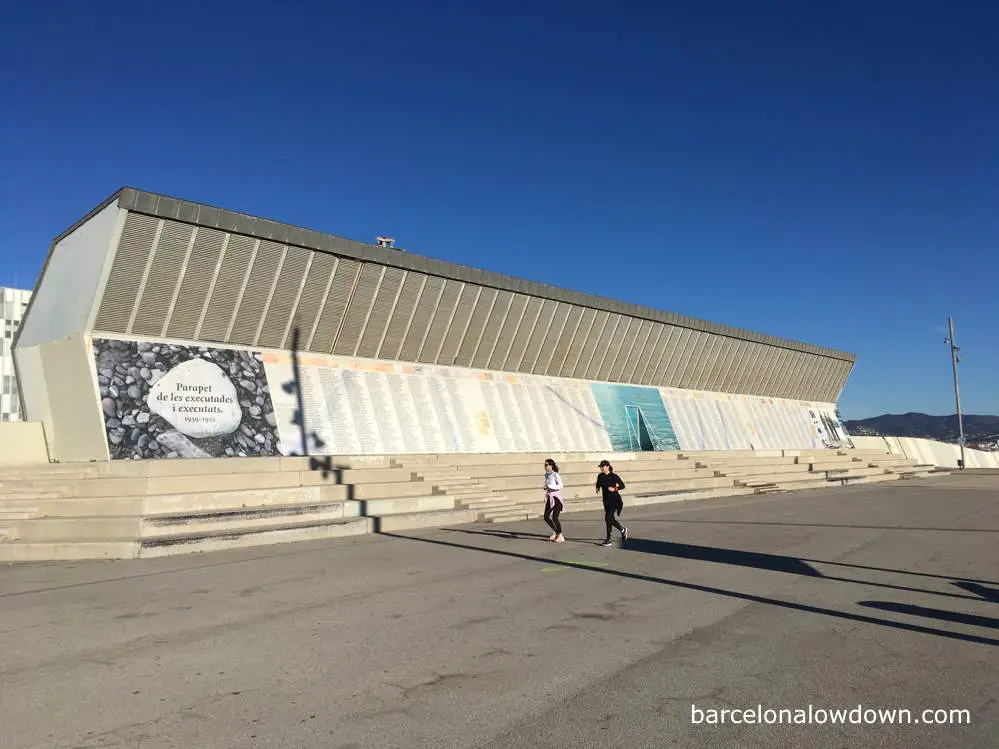The parapet of the people executed 1939-1952 (Catalan: Parapet de les executades i executats 1939-1952) is a fifty-five metre-long memorial to the 1,706 people executed in Barcelona during the early years of Franco’s dictatorship.
The executions were by firing squad, and victims were lined up against a concrete wall which stood next to an area of unauthorised housing called El Camp de la Bota, one of several shanty towns that were built in Barcelona during the early part of the twentieth century.
In addition to the Camp de la Bota, which was located at Barcelona’s northern limits, on the border between Sant Martí and Sant Adrià de Besòs, there were other areas of improvised housing on the Somorrostro beach, on the hillside at Montjuïc and on the Turó de la Rovira.

The Camp de la Bota took its name from a military building which was built here in 1858 and was originally used as a military academy and firing range.
During the Spanish Civil War, the building was converted into a military prison. After the war, the building continued to be used as a prison where people who had fought in the Republican army were imprisoned and executed.
In addition to republican soldiers, the victims of Franco’s firing squads included union members, socialist party members and basically anyone who had a political view which was contrary to the regime.
The executions continued until 1952, when Franco’s regime supposedly tried to “clean up its image” in preparation for the 35th Eucharistic Congress. Shortly after the congress, the prison was abandoned, and by the nineteen seventies, the shanty town had grown to a population of more than 3,000 people.
The Camp de la Bota shanty town was demolished during the late nineteen eighties, coinciding with the preparations for the Barcelona Olympics. Many of the inhabitants were rehoused in newly built apartment blocks. The area remained abandoned and in a state of neglect until the start of the twenty-first century, when it was converted into El Parc del Fòrum.
The Forum, or Fòrum de les Cultures to give it its full name, was a kind of Expo which took place in 2004 and was conceived by Barcelona’s then-mayor Pasqual Maragall. The idea was to create a new cultural event which would take place in a different city every three years.
In reality, the Forum was a flop, and they ended up giving most of the tickets away to local companies, associations and schools. The only people who seem to have benefitted from the forum were the owners and shareholders of the construction firms contracted to build a new marina, an amphitheatre and a number of large hotels and apartment blocks for the event.

In 2019, eighty years after the executions at the Camp de la Bota began, Barcelona city council commissioned Francesc Abad to create a monument to the people who had been executed.
The display, which includes the names of all 1,706 victims interspersed with black and white photos and copies of documents, was installed on an already existing wall of similar dimensions to that where the executions had taken place, now submerged under the waters of the nearby marina.
Location
The monument is located in the Parc del Fòrum in the Sant Martí district of Barcelona.
How to get there
The nearest metro stop is El Maresme | Fòrum, which is on Line 4 (yellow line). Metro T4 also stops nearby.
Other attractions nearby
- Barcelona Natural History Museum (Museu de Ciències Naturals de Barcelona)
- Bosc Urbà (Adventure playground)
- Barcelona’s beaches
- Palo Alto market
- La Rambla del Poblenou
Map
El Parc del Fòrum, Barcelona





Unfortunately I could not find an English version of a description of this document. It is only available in Catalan, which I can not read and understand. Thank your for this explaination and may be it will be copied into the official website of Barcelona.
It is very important to remember the politics of German and Italian and Spanish right-wing politicians in the past century and what they have done with people they do not want to exist. They killed them all.
Keep this memory and defend our freedom in Europe.
Hi Matthias,
Thanks for your comment, I’m glad you found this post interesting.
As you say, this type of monument plays an important role in making us aware of what happened in the past in order to, hopefully, avoid letting history repeat itself.